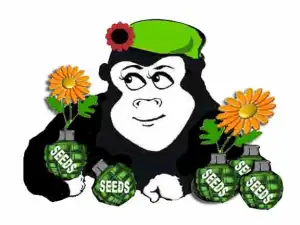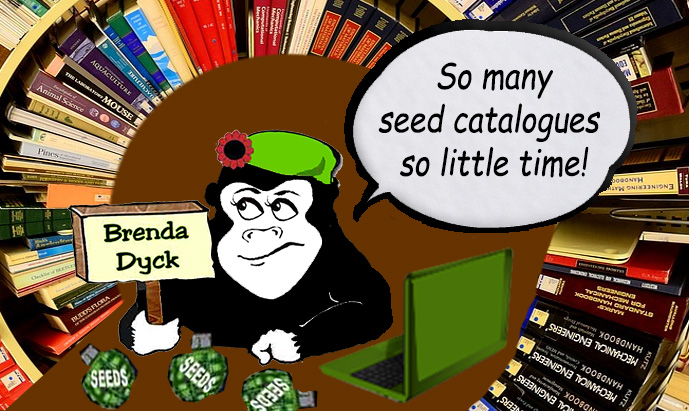A Guerrilla Garden Seed Packet Cheat Sheet

A Guerrilla Garden Seed Packet Cheat Sheet
“Packed for / Sell by Date”
This is the first thing I look for on a seed package. The “packed for” or “sell by” date helps to estimate how long the seeds will stay viable. As a rule I try not to buy out of date seeds or seeds that have no date at all, as the germination rate in my experience has been disappointing. However if I am looking for a particular type of seed and the only company that has it does not date their packets I will sometimes buy it anyways.
“A Favorite of Birds”
This means that you will want to avoid planting near cars, sidewalks, patios or picnic tables unless you would like a white wash of bird poop on everything. After all, what goes in, must come out!
“Moisture-loving”
There are two kinds of Guerrilla Gardeners when it comes to watering; the “I drown my plants” kind of gardener and the “I can’t remember the last time I watered” kind of gardener. Plants with “moisture loving” on the tag should only be attempted by the most diligent of watering types. All others had better have bog or swamp like place on their property if they want this type of plant to survive, let alone thrive!
“May require support”
This means that unless you start it off with a support system in place you will be so frustrated trying to do it later that the plant will most likely be ripped out and relegated to the compost heap. This is usually accompanied with a stream of interesting vocabulary and vows to never grow that particular plant again!
“Vigorous”
This is code for “incredibly invasive weed masquerading as a garden plant”. Just think of how fast mint spreads when planted and you’ll get the general idea.
“Prolific”
This usually means that you will have so many of whatever you planted that you will be giving some to everyone that you know until they start to avoid you.
“Carefree”
This refers more to the plant’s way of growing than to your gardening workload. If a tidy or neat garden is what you have in mind you might want to choose something else.
“Grandma’s Favorite”
Also sometimes labeled as “Heirloom”
These plants should only be grown if they are especially fragrant or an unusual variety, or if you want to save your own seeds. After all, a lot of the heirloom varieties quit being Grandma’s favorites when she discovered free-flowering, disease-resistant hybrids.
“Xeriscape Plant”
Also sometimes labeled as “Drought tolerant”
This is definitely the type of plant for the “I can’t remember the last time I watered” kind of Guerrilla Gardener. I don’t think of it as being lazy; I think of it as being environmentally water conscious.
“Days to Germinate”
This is the estimated number of days you will have to wait after planting the seeds (or seed bombing) before things will start to sprout. Some seeds will germinate quickly and others will take weeks. Regardless of the germination date, the general rule of thumb is that the seeds will germinate when they are damn good and ready! They may decide to pop up after a day or two, or they may wait long after their expected germination date to make an appearance. Or they may never germinate at all. However, never give up hope.
I have seen non-germinated seeds spring up a year after being regulated to the compost heap. Just saying.
“Annual”
(Tender) (Hardy) (Half-Hardy)
Tender Annual – Make sure the soil is well warmed and you have a long enough growing season before planting these seeds. Most so called tender annuals are really tropical perennials (or houseplants) and can’t handle anything colder than about 55 degrees F.
Hardy Annual – Hardy annual seeds can handle being frozen in the soil and are often planted in fall or early spring. Once they become plants they can handle an occasional slight freezing.
Half-Hardy Annual – Half-hardy seeds can be direct sown after all danger of frost. The plants can survive a couple of brushes with chilly night temperatures (35 – 45 degrees F.) but anything colder and you will have mush on your hands!
“Biennial”
A plant that hopefully lives for 2 years.
“Perennial”
A plant that hopefully lives more than 2 years.
“Hybrid plants”
Also can be labeled as Hb, F1, or F2
A hybrid is a cross between two different plant varieties to get the best attributes of each variety. Saving hybrid seed is not recommended. The seed collected is often sterile (like a mule) or if it does germinate it has the potential to display the traits of one or both parent plants or be something totally surprising. This should only be tried by avid garden gamblers who are willing to risk potential disappointment and like surprises.
“Sweet Corn”
(S) (Su) (Se) (Sh2) or (Bt)
(S) – means it is an eating variety of corn rather than a field/ornamental type of corn.
(Su) – indicates a normal sugary variety that is best when cooked within 30 minutes of harvest.
(Se) – is an extra-sweet hybrid
(Sh2) – is a super-sweet hybrid that must self-pollinate …this means that they must be planted upwind of and some distance from other corn varieties to develop their super sweet taste.
(Bt) – is a type of genetically modified corn
“GMO”
(genetically modified organism)
This refers to the plants or animals created through the gene splicing techniques of biotechnology, and there now are foods created by merging DNA from entirely different species. If you’ve ever watched the movie or read the book the Island of Doctor Moreau this may creep you out a little.
“Non-GMO”
Basically non-GMO is to certify that a plant or animal has not been genetically modified by adding a small amount of genetic material from other organisms through molecular techniques.
“Tomatoes Seeds”
(Determinate) (Indeterminate) (Semi-determinate)
Determinate – A determinate tomato plant grows into a bush and the tomatoes ripen at or near the same time (usually over a 2 week period), and then the plants die. They are often good choices for container growing. Determinate types are also preferred by commercial growers who wish to harvest a whole crop at one time and are a preferred tomato plant choice for home growers interested in canning.
Indeterminate – Many, if not all, heirloom tomatoes are indeterminate. Indeterminate develop into vines and continue growing and producing tomatoes until they are killed by frost. This rampant type of tomato variety tends to out grow their stakes as they can easily grow 6-10 ft. and are preferred by home growers who wish to harvest tomatoes throughout the season.
Semi-determinate – Semi-determinate varieties will grow larger than determinate varieties, but are not as rampant as indeterminate ones. They typically grow 3 to 5 feet tall. They should be staked, but are less likely to outgrow their stakes than indeterminate types.
“Planting Depth”
If the packet has no specific instructions on how deep to plant seeds then just keep in mind that bigger seeds are planted more deeply and tiny seeds are just barely covered with a fine layer of soil. As a general rule, seeds should not be buried any deeper than 2 to 3 times their diameter.
“Heavy Feeder”
These plants are hungry for fertilizer, so you will need to pile on the poop (or fertilizer of choice) frequently if you want them to flourish!
“Days to Harvest”
This indicates how many days before your fruits or vegetables will start producing. Keep in mind that Mother Nature may decide to mess with this date due to her sometimes moody weather changes.
and there you have it…
A Guerrilla Garden Seed Packet Cheat Sheet
to help you decipher the real meanings on plant tags and seed packages.
 Brenda Dyck
Brenda Dyck
A Guerrilla Gardener on an Adventure!
